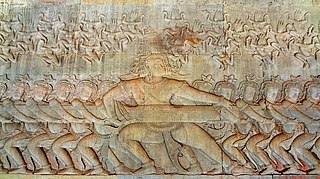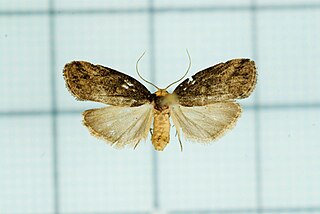
Asuras are a class of beings in Indian religions. They are described as power-seeking demons related to the more benevolent Devas in Hinduism. In its Buddhist context, the word is sometimes translated "titan", "demigod", or "antigod".

Deva means "shiny", "exalted", "heavenly being", "divine being", "anything of excellence", and is also one of the Sanskrit terms used to indicate a deity in Hinduism. Deva is a masculine term; the feminine equivalent is Devi. The word is a cognate with Latin deus ("god") and Greek Zeus.

Dracaena trifasciata is a species of flowering plant in the family Asparagaceae, native to tropical West Africa from Nigeria east to the Congo. It is most commonly known as the snake plant, Saint George's sword, mother-in-law's tongue, and viper's bowstring hemp, among other names. Until 2017, it was known under the synonym Sansevieria trifasciata. This plant is often kept as a houseplant due to its non-demanding maintenance; they can survive with very little water and sun.

The Samudra Manthana is a major episode in Hinduism that is elaborated in the Vishnu Purana, a major text of Hinduism. The Samudra Manthana explains the origin of the elixir of eternal life, amrita.

The golden coin turtle, also known commonly as the Chinese three-banded box turtle and the Chinese three-striped box turtle, is a species of turtle in the family Geoemydidae. The species is native to southern China. There are two recognized subspecies.

An asura in Buddhism is a demigod or titan of the Kāmadhātu. They are described as having three heads with three faces each and either four or six arms.

Argiope trifasciata is a species of spider native to North and South America, but now found around the world. It can be found in certain areas of Europe, namely the Iberian Peninsula, the Canary Islands, and Madeira. The similar looking Argiope bruennichi is common in the Azores. They typically begin to appear during autumn from early September to late October as temperatures start dropping. In Egypt, the type locality of this spider, females were found surviving the relatively warm winter months.

In Hindu cosmology, the Ocean of Milk is the fifth from the centre of the seven oceans. It surrounds the continent known as Krauncha. According to Hindu scriptures, the devas and asuras worked together for a millennium to churn this ocean in order to acquire amrita, the elixir of immortal life. The episode is mentioned in the Samudra Manthana chapter of the Puranas, a body of ancient Hindu legends. The Kshira Sagara is described as the place where the deity Vishnu reclines over his serpent-mount Shesha, accompanied by his consort, Lakshmi.
The Chinese false-eyed turtle is a hybrid species of turtle in the family Geoemydidae. It is a hybrid between a male golden coin turtle and a female four-eyed turtle. While formerly considered to be a wild type species believed to be originally from Hainan, it is now known only from pet trade type specimens.

The Vietnamese three-striped box turtle or green rice turtle is a species of the Southeast Asian genus Cuora. It is distributed from the extreme southern part of the Chinese Guangxi province southwards to central Vietnam and central Laos. This species reaches up to 30 cm straight carapace length and is thus the largest Cuora species. Due to demand of traditional Chinese medicine, this species is nearly extinct in the wild, but is readily bred on Chinese turtle farms. Extremely high prices are paid for this species in China. It can be distinguished from Cuora trifasciata by its larger size and generally more oval or rounder shell, which is usually also flatter, a white, pink, or orange chin, and head coloration with an orange-brownish-olive dorsal head pattern and less black pigment.

Asura is a genus of moths in the subfamily Arctiinae, and subtribe Nudariina erected by Francis Walker in 1854.

Eugoa is a genus in the family Erebidae, subfamily Arctiinae. The genus was erected by Francis Walker in 1858. They are found in India, Sri Lanka, Myanmar and Borneo.

Asura arcuata is a moth of the family Erebidae. It was described by Frederic Moore in 1882. It is found in India, Indonesia, Taiwan and Japan.
Asura avernalis is a moth of the family Erebidae. It is found on the Solomon Islands and Bougainville Island.
Asura discisigna is a moth of the family Erebidae. It is found in India and on Borneo.
Asura inconspicua is a moth of the family Erebidae first described by Frederic Moore in 1878. It is found in the Nilgiri Mountains of India.
Asura quadrilineata is a moth of the family Erebidae. It is found on Aru and in Australia.

Cyme sexualis is a moth of the subfamily Arctiinae first described by Felder in 1864. It is found on Ambon, Sulawesi, the Dampier Archipelago. and in New Guinea.

Aphantaulax trifasciata is a species of ground spider in the genus Aphantaulax, family Gnaphosidae.
Susna is an asura described in Hindu texts. Normally associated with drought, Susna is often described as possessing a snake-like form with horns. He is an enemy of the deity Indra.













